axle MAZDA MODEL MAZDASPEED 6 2006 Owners Manual (in English)
[x] Cancel search | Manufacturer: MAZDA, Model Year: 2006, Model line: MODEL MAZDASPEED 6, Model: MAZDA MODEL MAZDASPEED 6 2006Pages: 354, PDF Size: 6.5 MB
Page 134 of 354
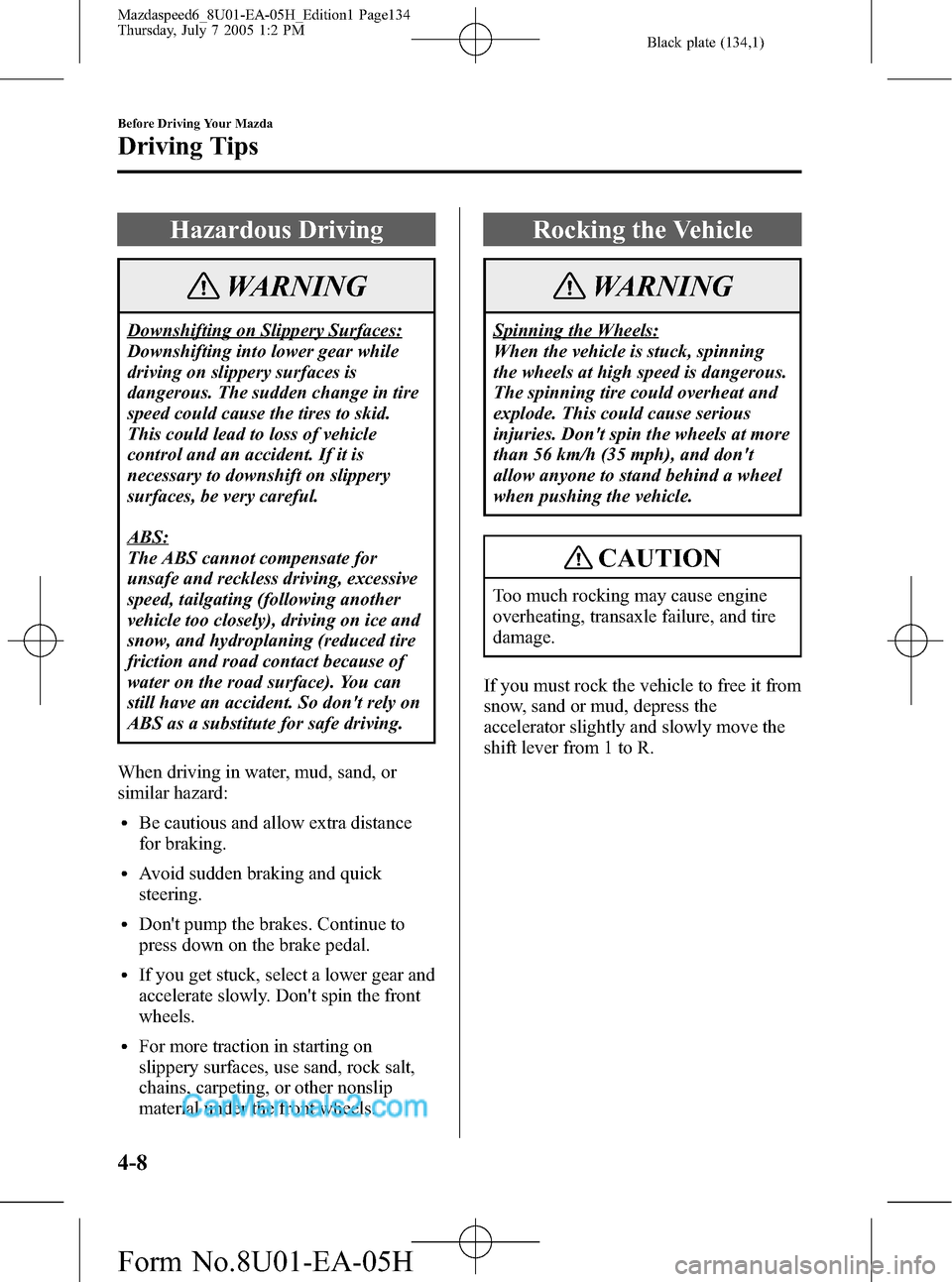
Black plate (134,1)
Hazardous Driving
WARNING
Downshifting on Slippery Surfaces:
Downshifting into lower gear while
driving on slippery surfaces is
dangerous. The sudden change in tire
speed could cause the tires to skid.
This could lead to loss of vehicle
control and an accident. If it is
necessary to downshift on slippery
surfaces, be very careful.
ABS:
The ABS cannot compensate for
unsafe and reckless driving, excessive
speed, tailgating (following another
vehicle too closely), driving on ice and
snow, and hydroplaning (reduced tire
friction and road contact because of
water on the road surface). You can
still have an accident. So don't rely on
ABS as a substitute for safe driving.
When driving in water, mud, sand, or
similar hazard:
lBe cautious and allow extra distance
for braking.
lAvoid sudden braking and quick
steering.
lDon't pump the brakes. Continue to
press down on the brake pedal.
lIf you get stuck, select a lower gear and
accelerate slowly. Don't spin the front
wheels.
lFor more traction in starting on
slippery surfaces, use sand, rock salt,
chains, carpeting, or other nonslip
material under the front wheels.
Rocking the Vehicle
WARNING
Spinning the Wheels:
When the vehicle is stuck, spinning
the wheels at high speed is dangerous.
The spinning tire could overheat and
explode. This could cause serious
injuries. Don't spin the wheels at more
than 56 km/h (35 mph), and don't
allow anyone to stand behind a wheel
when pushing the vehicle.
CAUTION
Too much rocking may cause engine
overheating, transaxle failure, and tire
damage.
If you must rock the vehicle to free it from
snow, sand or mud, depress the
accelerator slightly and slowly move the
shift lever from 1 to R.
4-8
Before Driving Your Mazda
Driving Tips
Mazdaspeed6_8U01-EA-05H_Edition1 Page134
Thursday, July 7 2005 1:2 PM
Form No.8U01-EA-05H
Page 136 of 354
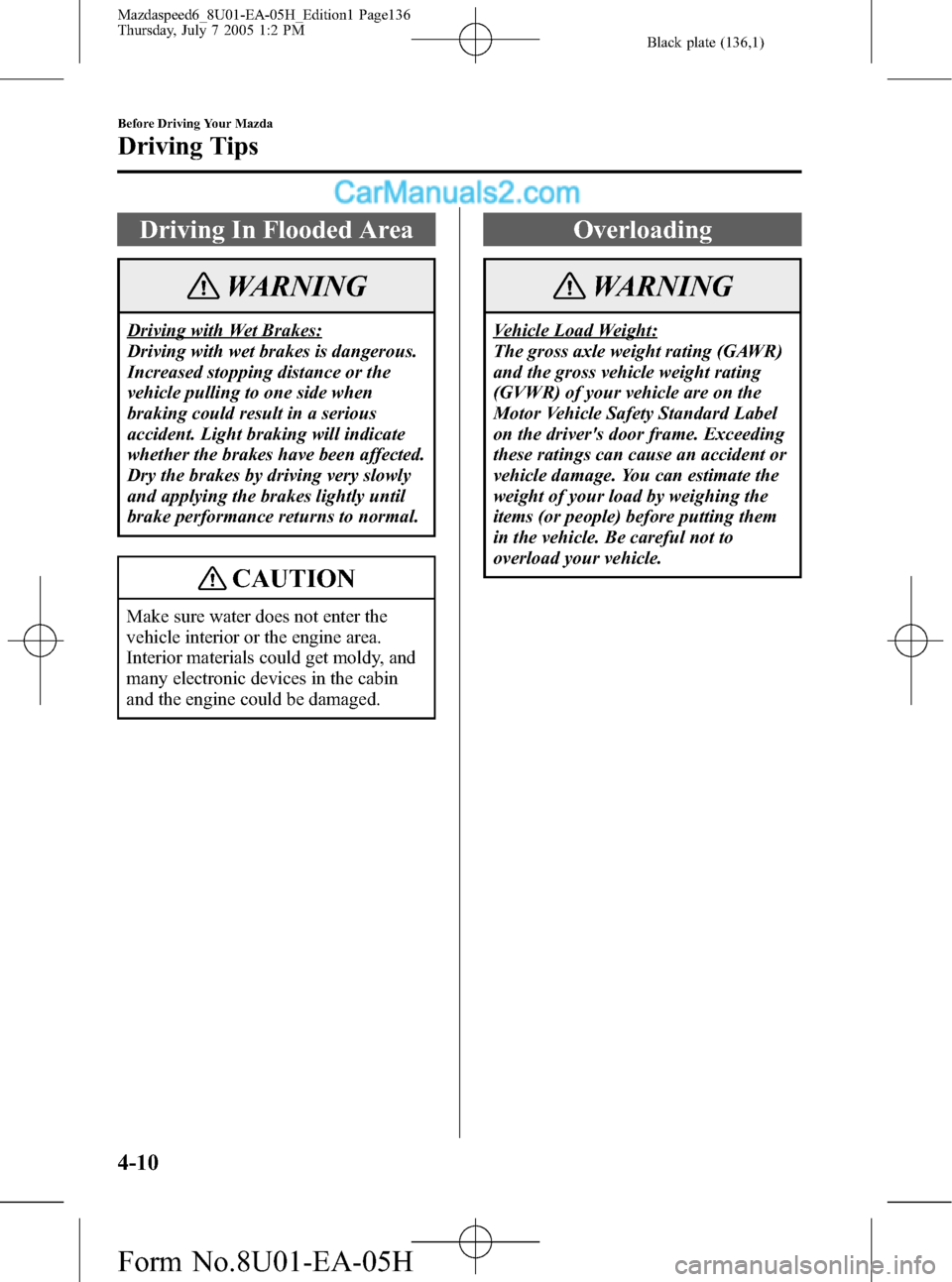
Black plate (136,1)
Driving In Flooded Area
WARNING
Driving with Wet Brakes:
Driving with wet brakes is dangerous.
Increased stopping distance or the
vehicle pulling to one side when
braking could result in a serious
accident. Light braking will indicate
whether the brakes have been affected.
Dry the brakes by driving very slowly
and applying the brakes lightly until
brake performance returns to normal.
CAUTION
Make sure water does not enter the
vehicle interior or the engine area.
Interior materials could get moldy, and
many electronic devices in the cabin
and the engine could be damaged.
Overloading
WARNING
Vehicle Load Weight:
The gross axle weight rating (GAWR)
and the gross vehicle weight rating
(GVWR) of your vehicle are on the
Motor Vehicle Safety Standard Label
on the driver's door frame. Exceeding
these ratings can cause an accident or
vehicle damage. You can estimate the
weight of your load by weighing the
items (or people) before putting them
in the vehicle. Be careful not to
overload your vehicle.
4-10
Before Driving Your Mazda
Driving Tips
Mazdaspeed6_8U01-EA-05H_Edition1 Page136
Thursday, July 7 2005 1:2 PM
Form No.8U01-EA-05H
Page 139 of 354
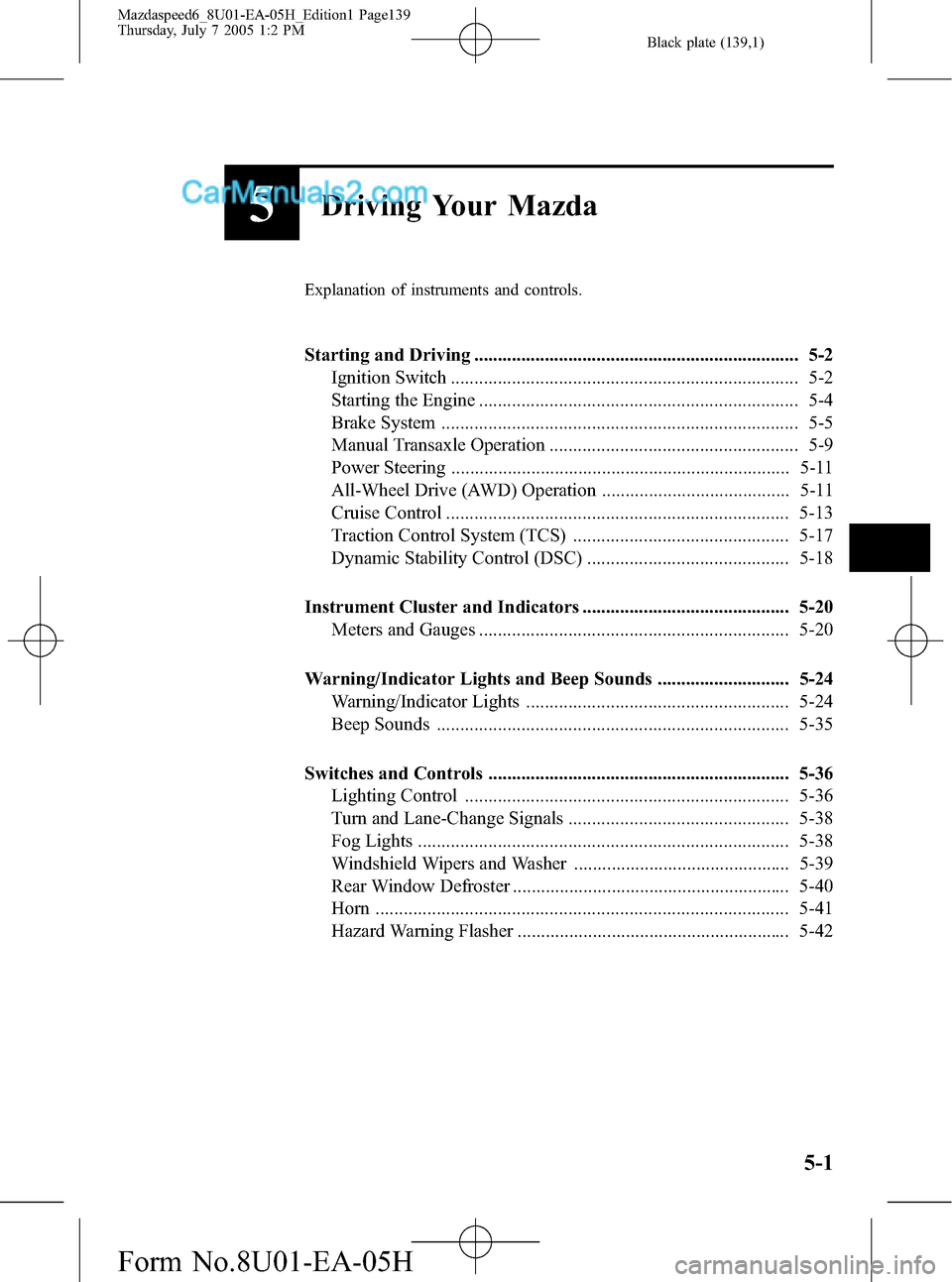
Black plate (139,1)
5Driving Your Mazda
Explanation of instruments and controls.
Starting and Driving ..................................................................... 5-2
Ignition Switch .......................................................................... 5-2
Starting the Engine .................................................................... 5-4
Brake System ............................................................................ 5-5
Manual Transaxle Operation ..................................................... 5-9
Power Steering ........................................................................ 5-11
All-Wheel Drive (AWD) Operation ........................................ 5-11
Cruise Control ......................................................................... 5-13
Traction Control System (TCS) .............................................. 5-17
Dynamic Stability Control (DSC) ........................................... 5-18
Instrument Cluster and Indicators ............................................ 5-20
Meters and Gauges .................................................................. 5-20
Warning/Indicator Lights and Beep Sounds ............................ 5-24
Warning/Indicator Lights ........................................................ 5-24
Beep Sounds ........................................................................... 5-35
Switches and Controls ................................................................ 5-36
Lighting Control ..................................................................... 5-36
Turn and Lane-Change Signals ............................................... 5-38
Fog Lights ............................................................................... 5-38
Windshield Wipers and Washer .............................................. 5-39
Rear Window Defroster ........................................................... 5-40
Horn ........................................................................................ 5-41
Hazard Warning Flasher .......................................................... 5-42
5-1
Mazdaspeed6_8U01-EA-05H_Edition1 Page139
Thursday, July 7 2005 1:2 PM
Form No.8U01-EA-05H
Page 147 of 354
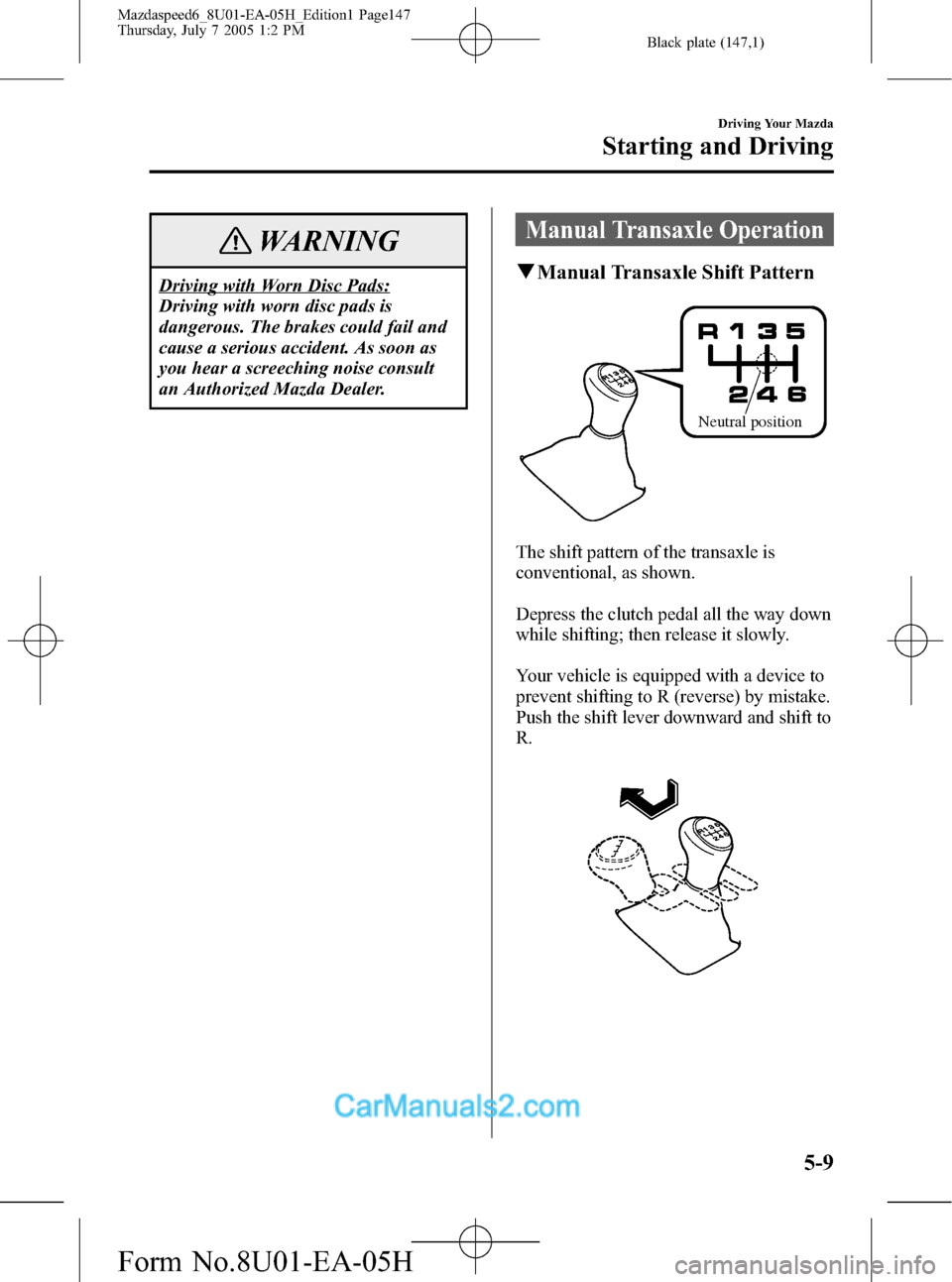
Black plate (147,1)
WARNING
Driving with Worn Disc Pads:
Driving with worn disc pads is
dangerous. The brakes could fail and
cause a serious accident. As soon as
you hear a screeching noise consult
an Authorized Mazda Dealer.
Manual Transaxle Operation
qManual Transaxle Shift Pattern
Neutral position
The shift pattern of the transaxle is
conventional, as shown.
Depress the clutch pedal all the way down
while shifting; then release it slowly.
Your vehicle is equipped with a device to
prevent shifting to R (reverse) by mistake.
Push the shift lever downward and shift to
R.
Driving Your Mazda
Starting and Driving
5-9
Mazdaspeed6_8U01-EA-05H_Edition1 Page147
Thursday, July 7 2005 1:2 PM
Form No.8U01-EA-05H
Page 148 of 354
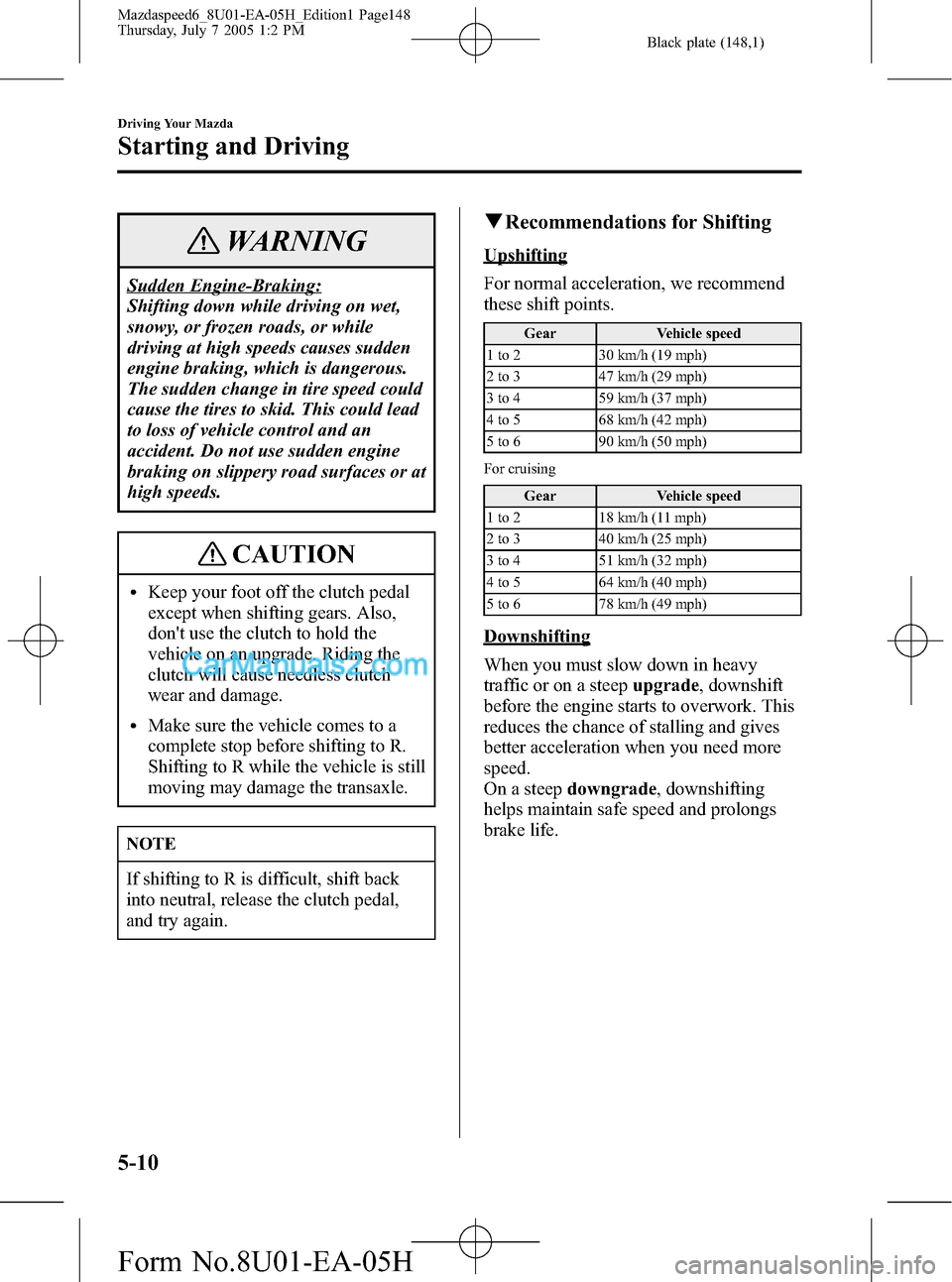
Black plate (148,1)
WARNING
Sudden Engine-Braking:
Shifting down while driving on wet,
snowy, or frozen roads, or while
driving at high speeds causes sudden
engine braking, which is dangerous.
The sudden change in tire speed could
cause the tires to skid. This could lead
to loss of vehicle control and an
accident. Do not use sudden engine
braking on slippery road surfaces or at
high speeds.
CAUTION
lKeep your foot off the clutch pedal
except when shifting gears. Also,
don't use the clutch to hold the
vehicle on an upgrade. Riding the
clutch will cause needless clutch
wear and damage.
lMake sure the vehicle comes to a
complete stop before shifting to R.
Shifting to R while the vehicle is still
moving may damage the transaxle.
NOTE
If shifting to R is difficult, shift back
into neutral, release the clutch pedal,
and try again.
qRecommendations for Shifting
Upshifting
For normal acceleration, we recommend
these shift points.
Gear Vehicle speed
1 to 2 30 km/h (19 mph)
2 to 3 47 km/h (29 mph)
3 to 4 59 km/h (37 mph)
4 to 5 68 km/h (42 mph)
5 to 6 90 km/h (50 mph)
For cruising
Gear Vehicle speed
1 to 2 18 km/h (11 mph)
2 to 3 40 km/h (25 mph)
3 to 4 51 km/h (32 mph)
4 to 5 64 km/h (40 mph)
5 to 6 78 km/h (49 mph)
Downshifting
When you must slow down in heavy
traffic or on a steepupgrade, downshift
before the engine starts to overwork. This
reduces the chance of stalling and gives
better acceleration when you need more
speed.
On a steepdowngrade, downshifting
helps maintain safe speed and prolongs
brake life.
5-10
Driving Your Mazda
Starting and Driving
Mazdaspeed6_8U01-EA-05H_Edition1 Page148
Thursday, July 7 2005 1:2 PM
Form No.8U01-EA-05H
Page 234 of 354
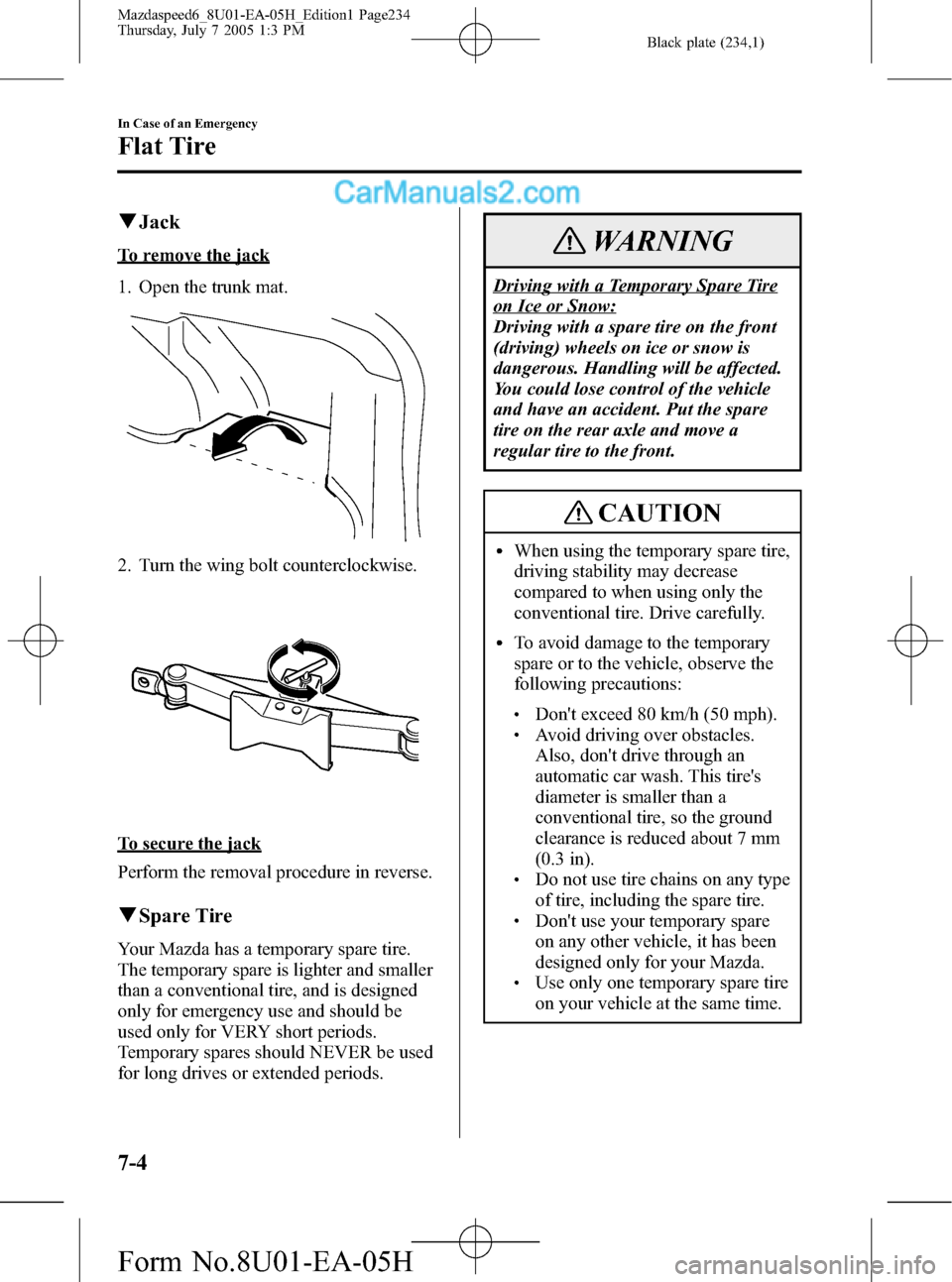
Black plate (234,1)
qJack
To remove the jack
1. Open the trunk mat.
2. Turn the wing bolt counterclockwise.
To secure the jack
Perform the removal procedure in reverse.
qSpare Tire
Your Mazda has a temporary spare tire.
The temporary spare is lighter and smaller
than a conventional tire, and is designed
only for emergency use and should be
used only for VERY short periods.
Temporary spares should NEVER be used
for long drives or extended periods.
WARNING
Driving with a Temporary Spare Tire
on Ice or Snow:
Driving with a spare tire on the front
(driving) wheels on ice or snow is
dangerous. Handling will be affected.
You could lose control of the vehicle
and have an accident. Put the spare
tire on the rear axle and move a
regular tire to the front.
CAUTION
lWhen using the temporary spare tire,
driving stability may decrease
compared to when using only the
conventional tire. Drive carefully.
lTo avoid damage to the temporary
spare or to the vehicle, observe the
following precautions:
lDon't exceed 80 km/h (50 mph).lAvoid driving over obstacles.
Also, don't drive through an
automatic car wash. This tire's
diameter is smaller than a
conventional tire, so the ground
clearance is reduced about 7 mm
(0.3 in).
lDo not use tire chains on any type
of tire, including the spare tire.
lDon't use your temporary spare
on any other vehicle, it has been
designed only for your Mazda.
lUse only one temporary spare tire
on your vehicle at the same time.
7-4
In Case of an Emergency
Flat Tire
Mazdaspeed6_8U01-EA-05H_Edition1 Page234
Thursday, July 7 2005 1:3 PM
Form No.8U01-EA-05H
Page 247 of 354

Black plate (247,1)
Push-Starting
WARNING
Towing a Vehicle to Start It:
Towing a vehicle to start it is
dangerous. The vehicle being towed
could surge forward when its engine
starts, causing the two vehicles to
collide. The occupants could be
injured. Never tow a vehicle to start it.
CAUTION
Do not push-start a vehicle that has a
manual transaxle. It can damage the
emission control system.
In Case of an Emergency
Emergency Starting
7-17
Mazdaspeed6_8U01-EA-05H_Edition1 Page247
Thursday, July 7 2005 1:4 PM
Form No.8U01-EA-05H
Page 248 of 354
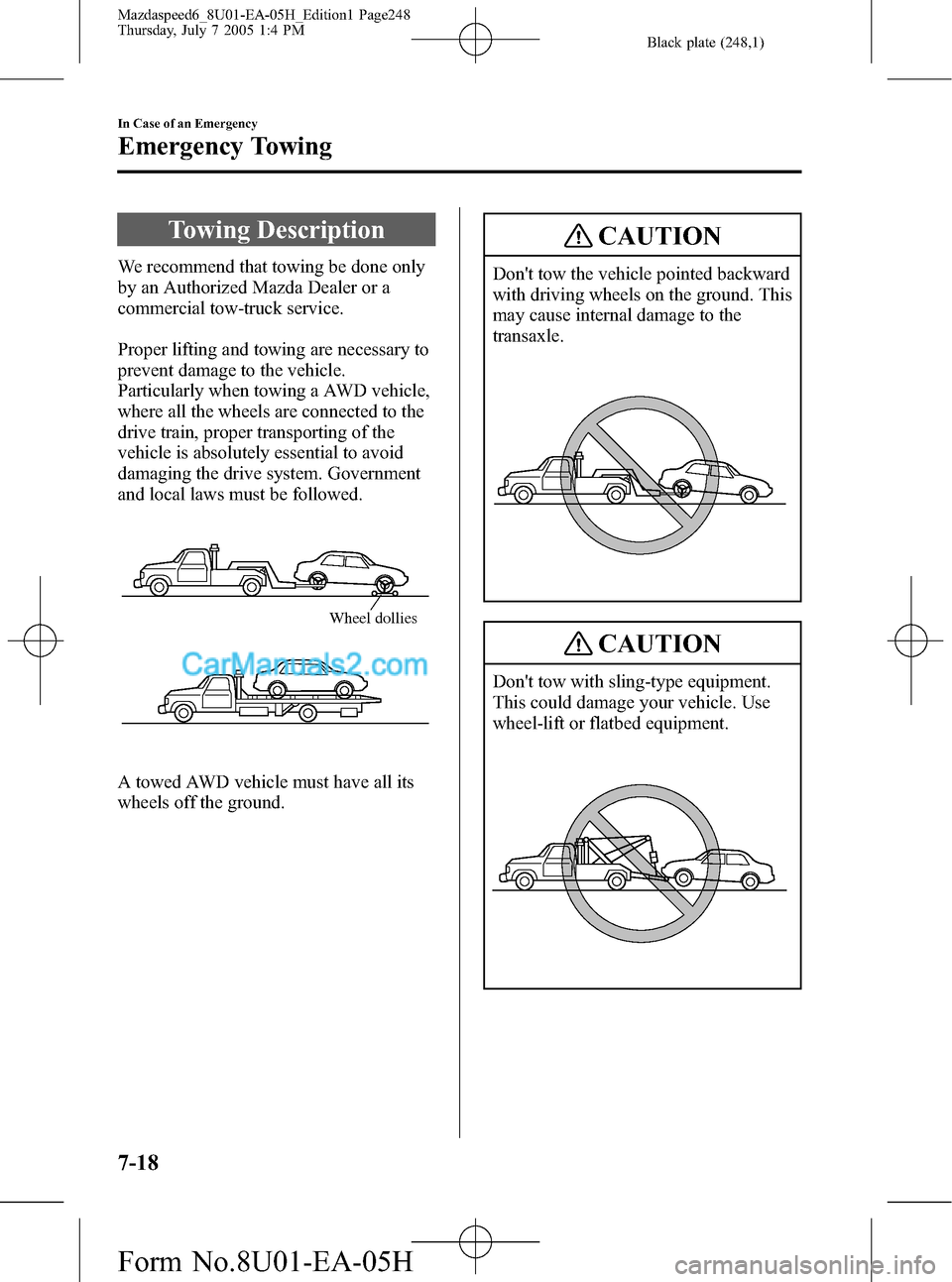
Black plate (248,1)
Towing Description
We recommend that towing be done only
by an Authorized Mazda Dealer or a
commercial tow-truck service.
Proper lifting and towing are necessary to
prevent damage to the vehicle.
Particularly when towing a AWD vehicle,
where all the wheels are connected to the
drive train, proper transporting of the
vehicle is absolutely essential to avoid
damaging the drive system. Government
and local laws must be followed.
Wheel dollies
A towed AWD vehicle must have all its
wheels off the ground.
CAUTION
Don't tow the vehicle pointed backward
with driving wheels on the ground. This
may cause internal damage to the
transaxle.
CAUTION
Don't tow with sling-type equipment.
This could damage your vehicle. Use
wheel-lift or flatbed equipment.
7-18
In Case of an Emergency
Emergency Towing
Mazdaspeed6_8U01-EA-05H_Edition1 Page248
Thursday, July 7 2005 1:4 PM
Form No.8U01-EA-05H
Page 251 of 354

Black plate (251,1)
CAUTION
If the tiedown eyelet is not securely
tightened, it may loosen or disengage
from the bumper when tying down the
vehicle. Make sure that the tiedown
eyelet is securely tightened to the
bumper.
Recreational Towing
An example of“recreational towing”is
towing your vehicle behind a motorhome.
The transaxle is not designed for towing
this vehicle on all 4 wheels.
When doing recreational towing refer to
“Towing Description”(page 7-18) and
carefully follow the instructions.
In Case of an Emergency
Emergency Towing
7-21
Mazdaspeed6_8U01-EA-05H_Edition1 Page251
Thursday, July 7 2005 1:4 PM
Form No.8U01-EA-05H
Page 333 of 354

Black plate (333,1)
Examples: Based on a single occupant weight of 68 kg, and a value of 385 kg for the
“combined weight of occupants and cargo should never exceed”:
The cargo weight limit with one occupant is 385 kg_
68 kg = 317 kg
The cargo weight limit with two occupants is 385 kg_
(68 × 2) kg = 249 kg
If the weight of the occupant increases, the cargo weight limit decreases by that much.
GAW (Gross Axle Weight)is the total weight placed on each axle (front and rear) -
including vehicle curb weight and all payload.
GAWR (Gross Axle Weight Rating)is the maximum allowable weight that can be carried
by a single axle (front or rear).These numbers are shown on the Safety Compliance
Certification Label located on the driver's door frame or door pillar. The total load on
each axle must never exceed its GAWR.
GVW
GVW (Gross Vehicle Weight)is the Vehicle Curb Weight + cargo + passengers.
GVWR (Gross Vehicle Weight Rating)is the maximum allowable weight of the fully
loaded vehicle (including all options, equipment, passengers and cargo).The GVWR is
shown on the Safety Compliance Certification Label located on the driver's door
frame or door pillar. The GVW must never exceed the GVWR.
Customer Information and Reporting Safety Defects
Tire Information (U.S.A.)
9-33
Mazdaspeed6_8U01-EA-05H_Edition1 Page333
Thursday, July 7 2005 1:4 PM
Form No.8U01-EA-05H